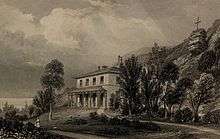Henry Beaumont Leeson
Henry Beaumont Leeson (1803–1872) was an English physician and chemist. His name is now known for a piece of optical apparatus.
Life
He was the son of Robert Leeson of Nottingham, and was educated at King's Cliffe school, Hammersmith, and Repton School. He matriculated at Caius College, Cambridge in 1822, graduating B.A. in 1826, and M.A. in 1829.[1]
Leeson studied medicine at St Thomas's Hospital in London, and graduated M.D. in 1840, at the University of Oxford. From 1840 to 1852 he acted as physician and lecturer on Chemistry and Forensic Medicine, at St Thomas's.[2] He was Treasurer of the Cavendish Society, set up in 1846 to print chemical works;[3] and was elected Fellow of the Royal Society in 1849. He belonged also to the Royal College of Physicians. and the Chemical Society.[2]

Leeson retired to the Isle of Wight, and a villa at Pulpit Rock near Bonchurch.[4] He owned and developed other properties in the area.[5]
Works

In 1843 he published a paper on circular polarisation of light and various essential oils. His optical apparatus was innovative, and he developed a double refracting goniometer, also known as a Leeson prism. It was made from Iceland spar, and later applied to the measurement of angles in small crystals.[6][7] The invention became standard. Leeson's goniometer, to be fitted to a microscope eyepiece, was illustrated in Knight's New Mechanical Dictionary (1884);[8] and its measurement technique, by bringing two images of a crystal into coincidence, was still explained in a text of 1921.[9] Leeson is also credited with the first rotation apparatus for orienting a crystal.[10]
Notes
- ↑ "Leeson, Henry Beaumont (LY822HB)". A Cambridge Alumni Database. University of Cambridge.
- 1 2 Royal Society Page
- ↑ Abraham Hume and A. I. Evans, The Learned Societies and Printing Clubs of the United Kingdom (1853), p. 293; archive.org.
- ↑ Thomas Barber, Barber's Picturesque Guide to the Isle of Wight (1850), p. 74***;archive.org.
- ↑ William Bernard Cooke, Bonchurch, Shanklin and the Undercliff (1849), note p. 13; archive.org.
- ↑ H. B. Leeson, Observations of the Circular Polarization of Light by Transmission through Fluids, London and Edinburgh Philosophical Magazine vol. 25 (3rd Series) (1844), pp. 416–434; archive.org.
- ↑ Albert Johannsen, Manual of Petrographic Methods (1918) pp. 293-4; archive.org.
- ↑ Edward Henry Knight, Knight's New Mechanical Dictionary. A description of tools, instruments, machines, processes, and engineering. With indexical references to technical journals (1876-1880) (1884) p. 408; archive.org.
- ↑ Conrad Beck; The Microscope vol.2 (1921), p. 212; archive.org.
- ↑ Johannsen, p. 300; archive.org.